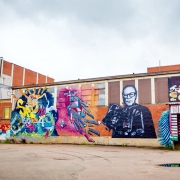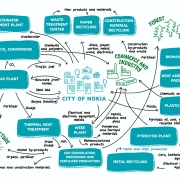Mission: Waste to Wealth
India is heading towards a zero-waste nation.
The Indian population of more than 1.3 billion currently generates about 62 million tons of municipal solid waste annually. About 377 million Indian citizens residing in urban areas contribute an estimated amount of 55 million tons.
Approximately 80 percent of the waste ends up in landfill, about 20 percent of that is being treated. Recycling is often carried out by the informal sector; around 1.5 million “waste pickers” are supposed to deal with the collection and recycling of waste. By 2041, annual waste generated in India is predicted to reach more than 160 million tons.
Recyclable garbage might help generating 30,000 crore Indian Rupees (converted: 3,625,500,000 US-Dollar) per year, reported The Times of India in May last year. The third-largest newspaper and digital news medium referred to a report titled ‘Circular Economy in Municipal Solid and Liquid Waste’ that had been prepared by the Indian Ministry of Housing and Urban Affairs (MoHUA) in 2021.
As stated in the report, an estimated 55 million tons of municipal solid waste is generated annually in India by 377 million citizens residing in urban areas. However, India’s urban population is expected to grow to 600 million by 2030 and to 814 million by 2050. That also means that the amount of waste will grow. Accordingly, India would set to generate 165 million tons of waste by 2030 and 436 million tons by 2050. As a result, the annual greenhouse gas emissions from municipal solid waste is expected to go up to 41.09 million tons, the authors wrote. Therefore, they recommended a circular economy approach “that looks at sustainable waste management and optimum utilization of resources – key to an AatmaNirbhar Bharat”.
Potential for resource recovery
In the report, municipal solid waste is categorized into wet waste, dry waste as well as construction and demolition waste. An analysis by MoHUA identified a significant potential for resource recovery from these waste categories through circular economy. For example, dry waste recycling would have the potential to generate approximately 11,836 crore Rupees (converted: about 1.43 billion US-Dollar) per annum, and compost as well as bio-CNG (compressed natural gas) from wet waste could generate revenues of nearly 365 crore Rupees (about 44 million US-Dollar) and 1,679 crore (roughly 202 million US-Dollar) per annum respectively.
According to the report, C&D waste has the potential to generate revenues of approximately 416 crore (about 50.2 million US-Dollar) per annum. A similar trend is seen in the liquid waste space: revenues amounting to 6,570 crore (nearly 800 million US-Dollar) and 3,285 crore (nearly 400 million US-Dollar) per annum for treated sludge and wastewater. India generates approximately 1.45 lakh metric tons (145,000 metric tons) of solid waste daily, 35 percent of which is dry waste. “Thanks to India’s informal sector, a majority of the plastic waste is recycled,” the authors of the report gave account.
Plastic is the major component. India generates approximately 9.4 million tons per annum of plastic waste (which amounts to 26,000 tons per day), out of this approximately 5.6 million tons of plastic waste is annually recycled (about 15,600 tons per day). However, 3.8 million tons of plastic waste is left uncollected or littered (9,400 tons per day) per annum. “Though plastic recycling in India is almost three times the global average, there are no comprehensive methods in place for plastic waste management.”
According to the report, there are also challenges with other waste components. For example, small metal scraps are often lost due to inefficient segregated waste collection and waste tracking, resulting in the loss of valuable metal resources. Similiarly, that also applies for the recycling of glass and ceramic waste. Nearly 45 percent of glass is making its way into recycling. “Risks of injuries and issue of breakages while handling glass and ceramics makes it less attractive to recyclers and handlers,” the authors informed. “Though glass segregated by colors has an established market, yet lack of segregation and availability of glass is neither reported nor is there an established mechanism of communication between cities and the glass recycling industry.” In addition, the recycling rate of textiles could be better. According to the study, the textiles industry in India reports that more than one million tons of textiles are discarded anually, most of this coming from household sources. While the industry had a recycling potential of 50 percent, only 25 percent were being recycled/reused. “Even though age-old circular (reuse and refurbish) barter system still exists in small towns, there is limited collection and recycling system for textiles.” Furthermore, tire recycling has also room to improve. “Currently, there is no tracking of discarded tires and monitoring of their disposal across India. Though retreading of tires by unorganized sector is a common practice, a large portion of the scrap tires are dumped in landfills.”
As stated, the informal sector plays a major role in making the material flow of dry waste value chain resource efficient and circular by sorting the dry waste into different components and recovering valuable resources. “Yet, lack of integration of informal sector into the mainstream recycling industry leads to limiting their involvement to only certain fractions of waste. Furthermore, these workers are plagued with low wages and exposed to significant health risks.”
“Recycling is a crucial part of the circular economy”
The authors of the study regard the circular economy as part of the solution. The savings from circular economy in India were estimated at 624 billion US-Dollar in the year 2050, they referred to a KPMG study. “To move towards a circular economy in dry waste, the design and material aspect related to production must be addressed,” they wrote. “Recycling is a crucial part of the circular economy, but the goal of ‘true recycling’ is that of converting the waste resource back to its original form, without sacrificing quality or integrity in the process. The recycled material should be at par with what was originally created using virgin raw material, for true circularity.”
The authors additionally provide advice on the improvement of circularity in India. Their recommendations include:
- develop circular economy guidelines with circularity targets for each dry waste component
- national policy for marine plastic
- policy for mainstreaming informal workers, mandating their formalization
- policy for setting-up waste management parks, recycling zones
- make waste management a priority sector for lending and environmental clearances
- expand EPR (extended producer responsibility) to include other dry-waste components: paper, textile, rubber, metals and glass, to name but a few
- funding for research & development of product re-design, remanufacturing and alternate materials based on life cycle assessment (LCA) and material flow assessment (MFA)
- technical guidelines for production, usage, and recycling of bioplastics.
For regulatory interventions, they recommend, inter alia, a standing task force to drive and monitor the circular economy initiatives across all dry waste components and value chains. The report also suggests a digital platform to capture end-to-end dry waste material flow data for transparency and traceability as well as the mandating use of 25 percent recycled materials in the non-food grade packaging to ensure uptake of recycled materials. Regarding the infrastructure, the authors propose – among other things – mechanisms for single window clearance, simplified registration and compliance processes for recyclers and waste management agencies, incentives to use RDF (refuse-derived fuel) in cement kilns to save coal as a resource, land allocation to set-up waste management parks and recycling zones as well as an innovative financing mechanism to support recycling infrastructure.
Aim: Waste to Wealth Authority
The Swachh Bharat Unnat Bharat Abhiyan, set up under the Prime Minister’s Science, Technology and Innovation Advisory Council (PM-STIAC), is an initiative by the Office of the Principal Scientific Advisor to the Government of India (PSA) in partnership with Invest India, the national investment promotion and facilitation agency. As reported, the initiative “will leverage global technological capabilities to create socio-economic benefits for 1.3 billion Indians by addressing the issues of waste disposal, deteriorating air quality and increasing pollution of water bodies”. According to the information, PM-STIAC intends to establish a “Waste to Wealth Authority” that will employ latest technologies across states to address the problem of waste generation.
The Waste to Wealth mission “aims to identify, test, validate and deploy technologies to treat waste to generate energy, recycle materials, and extract resources of value and provide technology database of national and international technologies to support Urban Local Bodies address their waste challenges,” Invest India informs on its homepage. “The mission will assist and augment the Swachh Bharat and Smart Cities projects by leveraging science, technology, and innovation to create circular economic models that are financially viable and sustainable for waste management to streamline waste handling in the country.”
www.investindia.gov.in/waste-to-wealth
www.psa.gov.in/mission/waste-wealth/38
(Published in GLOBAL RECYCLING Magazine 1/2023, Page 3, Photo: Phuong / stock.adobe.com)







